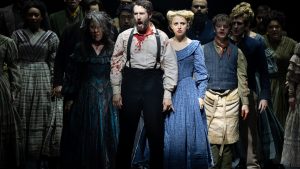
The classic Billy Wilder 1959 movie is generally considered one of the greatest films ever made. Some Like It Hot was also groundbreaking in its time for featuring gender ambiguity. The movie was released without approval from the Hays Code due to its content. The Code disappeared in the mid- 1960s in part due to this movie’s huge success.
A Broadway environment where gender acceptance is a major theme in nearly every musical makes revisiting this material timely. The pedigree of the creative team ensures success. Marc Shaiman and Scott Wittman (Hairspray) wrote the tunes. Matthew López (The Inheritance) and comedienne Amber Ruffin penned the book. Casey Nicholaw (The Drowsy Chaperone, Aladdin, The Book of Mormon, Something Rotten!) directed and choreographed. That is a enormous pile of hits.
This adaptation is built to be a big showy Broadway musical comedy filled with eye filling dance numbers, costumes and sets. There are numerous pleasures to be savored. The production falls short of greatness probably because it is oddly less edgy than the original. Some lines do hit the mark: “we sat alone just fingering our scales”.
Joe/Josephine and Jerry/Daphne are confidently played by the reliably hilarious Christian Borle and a wonderfully transformational J. Harrison Ghee. Their early tap duet “You Can’t Have Me (If You Don’t Have Him)” is a winner, establishing the tone of what will follow. You likely already know they have to escape the gangsters. They skip town crossdressing as women before joining a traveling all-girl band.
Raena White is a boisterous Sweet Sue who attempts to keep her girls in line. Kevin Del Aguila undeniably steals the show as Osgood, the wealthy Mexican bachelor who woos Daphne. Everything he does is quirky and magnetic. All the villains are cartoonishly mean, fun and ridiculous hams.
The all-girl band is a mixed bag. Two veterans (Angie Schworer and Jenny Hill) outshine the younger chorines by an incredibly obvious amount. They look gorgeous and are beamingly alive on stage. The others, in comparison, are distant and flat which deflates some of the group numbers. Just watch the “old” ladies. They are awesome throughout.
Adrianna Hicks (Six) has the unenviable task of inhabiting Sugar, one of Marilyn Monroe’s iconic roles. Her voice is very nice and she exudes chemistry with Mr. Borle during the yacht scene. The overall characterization is pretty ingenue rather than oft jilted, slightly damaged goods. Waving a flask around doesn’t hide the disappointing tameness.
A Casey Nicholaw show always contains in-your-face entertainment and immense production numbers. You can count on that here. “Tip Tap Trouble” near the end of Act II is justifiably a show stopper. You cannot possibly watch it without smiling.
Some Like It Hot balances messaging with entertaining well. The world has progressed immensely since 1959 and, despite some pathetically self-righteous conservative prudes, most people support the idea that people should be their authentic selves. I assume the classic ending line from the film was eliminated as a result of changing times. I missed hearing it but, after all, nobody’s perfect.










You must be logged in to post a comment.